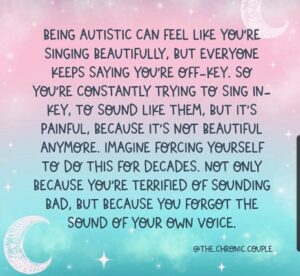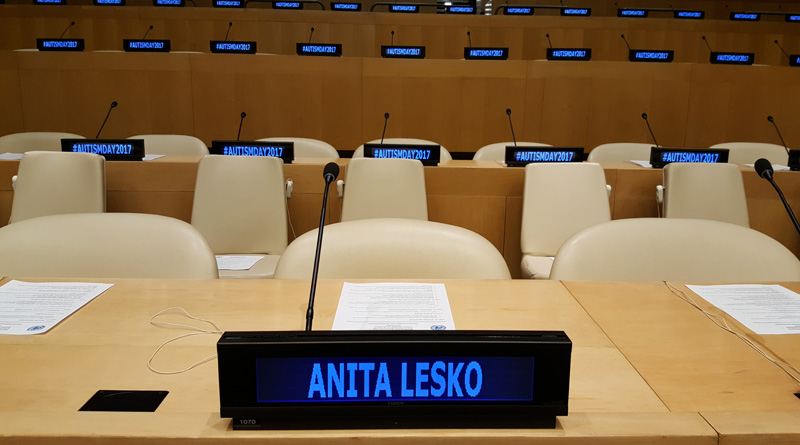
Masking or Camouflaging: An Autistic Self-Advocate Dialogue
By Sean M. Inderbitzen LCSW
In this article, Sean is joined by Lisa Morgan M.Ed. CAS. Lisa is Co-chair Autism and Suicide Committee of AAS
Board certified Autism Specialist. For more about Lisa’s work, visit www.autismcrisissupport.com
Masking or Camouflaging?
In their work on Autism and Suicidology a team of subject matter experts, Lisa Morgan, Dr. Brenna Maddox, Sara Cassidy, Mary Donahue, Teal Benevides, and Mirabel Pelton developed a toolkit (https://belong.coventry.domains/wp-content/uploads/2021/09/Warning-Signs-Resource-Sept-2021.pdf). In it (they propose 10 warning signs of suicide for autistic people) they trace ten common symptoms of increased risk for suicidality, and in this article I want us to focus on Statements of no purpose for living. In it they write:
There is limited research in this area. Similar to Timmy and Terrance, research suggests that autistic people report feeling thwarted belonging (loneliness and/or absence of feeling socially accepted) more frequently than non-autistic people. This is a consequence of not being accepted for their true self and having to mask or camouflage autistic characteristics to survive in a world not designed for the autistic minority (Bradley et al., 2021; Cassidy et al., 2020; Mitchell, Sheppard, & Cassidy, 2021)
SEAN: While this perspective on highlighting feelings of loneliness is a helpful experience to highlight within the autistic experience, it again places the emphasis to change on society rather than focusing within on change. From an Internal Family System perspective that change would need to come from within the relationship of the parts, not the external lotus of change. To reiterate Internal Family Systems theory posits that individuals are comprised of a set of parts that make up the self. Abandoning the myth of the self, these parts are organized into three types of parts: Protectors, Managers, and Exiles. Protectors are those parts of the self which desire to protect exiles from the pain and suffering they perceive exiles incapable of handling. Managers are parts of the self which find ways to take the pain away from the exiles as they perceive the exiles of being incapable of handling the pain. Exiles are those younger parts of the self, which often hold the key to healing, but lack a sense of being acknowledge ore even accepted.
It is the work of IFS therapists then to help the person in which these parts reside to provide space to these different types of parts via a resourced adult self-located within the person which the parts reside in. Masking can be viewed within the IFS frame as an adaptive strategy or in more evolutionary language as camouflaging. Outside of the context of autism and within the animal kingdom animals use this strategy to blend in and even avoid being prey akin to iguana’s which change color to avoid being eaten. In the same way so to do human beings regardless of neurological orientation do this same adaptive strategy. If one wishes to success within the workplace the impetus is to adapt to company culture to not only succeed in the workplace but to advance and move forward in ones career within a workplace. So too, can autistic masking be viewed of in this way, masking oneself for the survival of a person within what feels like a threatening world. However, while this strategy of trying to be more neurologically similar to others is adaptive at first, it does come at a cost, which often involves alienation of the self, leading to parts becoming exiles.
LISA: The purpose of masking is to stay emotionally, socially, safe from rejection, bullying, and ostracization. It’s also to be socially successful and to be able to have a job, a meaningful relationship, go to school, etc. What changes can an autistic person do within themselves, using the Internal Family System, to stop the rejection, bullying, and ostracization from peers, colleagues, clinicians, etc.?
As well, while camouflaging can help someone blend in and succeed at work, like it helps animals to stay hidden and not be eaten, the goal for many autistic people is broader than just merely survival. Many autistic people want to belong and to be a part of the workplace where they spend so much of their time. As well, being part of a workplace, making connections, can help their overall success.
The Development of Masking
SEAN: An important distinction to make is that the internal family system is the family of parts, not an actual family system. This distinction is important to make as it is easily confused. From an IFS lens, masking is an adaptive strategy likely an exile part (for more on what IFS is see here- reference article on ASD and IFS) that developed at an early age. Probably with a developmental age of around 3 to 5, so too is its perception of the world. Likely at this time in the development of the autistic childhood of an individual this part developed due to some type of adverse experience, in which there was significant pain in being different.
As a result this 3-5 year old exile part forms around it this maladaptive strategy of changing who it is to meet the needs of others, often times at its own expense. To give you an example, pretending to be okay with pot to impress others within a social group even though the autistic person is not okay with pot on any level because their mom died from it. This experience of being a human pretzel has much less to do with others, and much more to do with lack of acceptance of this exile part by the adult autistic self.
In terms of dealing with the rejection, bullying, and ostracization from peers, colleagues, clinicians, etc. as Lisa puts it, from an IFS lens this is the work of holding space and being present with all of ones parts. These parts are often the results of rejection, bullying, or likely far worse. While bullying and ostracization, they fail in comparison to the challenges therapists face when utilizing IFS to treat patients with structural disassociation. Take for instance, Dissociative Identity Disorder (formerly Multiple Personality Disorder), which is a splitting of parts and a loss of awareness between them. The trauma’s endured by these individuals tend to be inclusive of early childhood experiences which split identity (e.g. childhood sexual molesting, rape, physical violence, negligence, etc.). This is not to minimize the experience of those who are rejected, but to claim they are on the same playing field is not even remotely comparable. In performing Internal Family Systems Therapy there is an emphasis on making space and time for ones internal parts to cultivate connection over the loss shared and experienced, in an effort to reduce alienation.
LISA: While I agree with your masking beginning as an adaptive strategy around the 3- to 5-year-old developmental stage due to a(n) adverse experience(s), I disagree with your example. I don’t believe masking has to do with peer pressure as much as it has to do with peer acceptance. Masking is suppressing every piece of your autistic self that may reveal it to others. It’s also ignoring (and not attending to) any stimulus from the environment. Then, pretending to be okay with pot to impress others within a social group. Masking is much more intrusive to self.
SEAN: Masking from an IFS lens has some to do with fear of others, but far more to do with fear of being oneself, which when we think about it from the lens of a family of parts has more to do with the relationships in which we experience within ourselves. This internal network likely involves the alienation of this young exile, by its fellow protector and manager parts. Strategies which are likely equally maladaptive and adaptive at times, they spend time alienating this 3-5 year old exile, who probably longs for nothing more than to find its own acceptance by others. To quote Gabor Mate, in his new book The Myth of Normal, he writes, “Trauma….may through sheer force of denial engender a naively rosy perspective that blinds but to real and present danger- a veneer concealing fears we dare not acknowledge. One may also come to dismiss painful realities by habitually lying to oneself and others. (Mate 32) In short, a super common trauma response is denial of the present, for feeling the present would be too much. In short to be autistic and engage in masking is to shield ones’ parts from oneself, for to face the sheer pain of being different is perhaps unbearable. Thus alienation becomes the tool by which Autistic people become both disengaged from the present and themselves through the tool of masking.
LISA: Masking has to do with autistic people fearing the reaction and subsequent rejection by their peers of who they inherently are as people. For example, autistic people do not feel the need to mask when they are with other autistic people. If they feel that aspects of their autism will be accepted, they themselves will be accepted, so they do not feel the need to mask. Autistic people tend to unmask when they are by themselves, with no fear of being themselves.

Masking and the Social Model of Disability
SEAN: Masking is an inherently self-directed behavior, not externally. The extent to which they can even turn it off with or without other autistic people is hardly understood. I think to feel safe with other people in your tribe is a relatively ancient experience for most tribes. The idea that we might experience safety during a time when a person is part of an in group makes sense. However this does not imply that it always happens as assumed here. Additionally, physiological data not support this position generally speaking. If we look at the autistic person from a strictly biological perspective, autistic heart rates are consistently higher than those of their neurological normed peers. This is important in that it indicates that the autistic nervous system resides in a frequent if not almost chronic state of fear. Other people present or not does not change that the autistic person has difficulty accessing a state of safety. Unmasking or entering a state of safety, in which people can be creative, cognitively flexible, and socially engaged means finding a way to not due the chronically practiced states of threat. Autistic nervous systems don’t occupy a state of safety without some significant amount of work. I’m not sure that even when autistic people are more themselves they can really maintain it the way someone who is not diagnosed with autism can. The ability to regulate and feel safe is significantly impaired in people with autism for better or worse.
I offer this perspective as an alternative to the work of the research team because I don’t feel that the social model of disability is doing our movement any favors.
LISA: is masking supporting a social model of disability or is it pointing out a cultural difference that remains unaccepted? Autism does have a culture, and it’s not only not accepted, it’s hardly recognized.. So, autistic people have to mask their autism to fit into a culture that is different than theirs. I suggest the reason autistic people have a more difficult time regulating and staying regulated is because they live their lives in an environment not made for them and socialize within a culture different than theirs.
If a bee had to live within an ant colony instead of within its own hive, it would suffer greatly. Nothing within the bee could help its suffering to lessen. Masking as an ant would help the bee to be accepted, but the only thing that would truly help the bee would be if the ants could accept him as a bee, communicated with him in a way he understood, and to empower him to use his skills within the ant colony.
SEAN: In an IFS lens, it makes sense that people from a similar tribe might feel more safe with others like them than those without. To assume neurodiversity is an explanation and not a culture would be a misnomer. You are right it is a culture, and to quote Steve Silberman, it is even a tribe. A tribe in which perhaps some experience safety within the culture of an in group. However, neurodiversity remains unproven in large part, and placing the emphasis on society encourages change in a direction that is highly dependent on others, and does little to remedy the pain caused by self-alienation. Rather than wait for the changes of society to occur at whatever rate they may to me it seems far more in our interest to find change through greater acceptance of our many selves. The notion that Autistic persons are somehow skilled in being on their own and with themselves is not a privilege I have experienced or many of my autistic clients have experienced. While I cannot speak for all autistic folks, people with Autism are often not comfortable being in their own presence, as the impact of camouflaging is not something that stops upon the lack of presence of others
LISA: While I do agree with your perspective, there still remains the fact that most people do not feel the need to mask from themselves. It is a social strategy used to fit in with others. Masking helps to obtain employment, to get through college, to find and keep a friend, etc., all within society. Like I said earlier, masking is not from oneself, although masking can and often does cause a person to not develop a sense of self, therefore does affect one’s self-esteem, most autistic people are fine being with themselves and/or other people who accept them as autistic people.
“What is a poet? An unhappy person who conceals profound anguish in his heart but whose lips are so formed that as sighs and cries pass over them they sound like beautiful music.” – Søren Kierkegaard

Sean is a Behavioral Health Therapist, and lives with an Autism Spectrum Disorder. He has a caseload with 33% of his patients that live with ASD and varying comorbid psychiatric conditions. Prior to being a mental health clinician, he was a Vocational Rehabilitation Specialist for Wisconsin Division of Vocational Rehabilitation for 3 years. He was also appointed by Governor Walker to the Statewide Independent Living Council of Wisconsin. He is an incoming member to the Motivational Interviewing Network of Trainers, and provides training on motivational interviewing, ASD and employment, and ASD and comorbid psychiatric conditions. For more info, find him at Seaninderbitzen.com or on LinkedIn, and look for his new book Autism in Polyvagal Terms: New Possibilities and Interventions.




